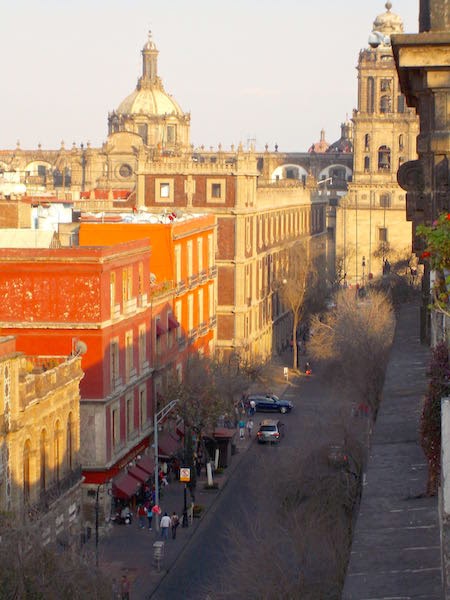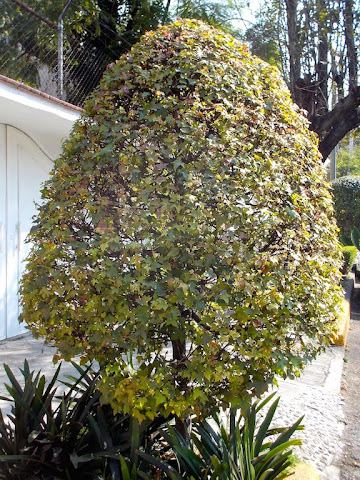Our flight to Mexico City was uneventful, following a slight delay due to a faulty door on the plane that wouldn't shut properly. We had read recommendations about taking a bus from the airport to the Centro Historico so we did, although it was more expensive than the subway. We thought it would allow us to see more of the scenery, but the views of dusty streets were not really worth it. In addition, it seemed we'd caught the one bus that didn't go past our hotel. Fortunately, the usual kindness of strangers was in play, and a nice woman getting off at the closest stop led us the few remaining blocks to the hotel entrance.
I had requested a room "con balcon y vista" and we were shown into a large room on the top floor with two queen beds and a terrace overlooking roofs and the street.
 |
We spent what was left of the afternoon strolling the surrounding streets, enjoying the architecture and the people.
Around the dinner hour, we found ourselves at Sanborns, the historic flagship store of a chain owned by Mexican billionaire Carlos Slim, the world's richest man. We managed to get a table in the restaurant, located on the ground floor of a vast atrium. The food was only average, but the setting was lovely.
In another part of the same building was a more casual cafe with traditional diner stools and counters ...

... under some iron elaborate chandeliers.
Most of the places we wanted to visit were closed on Mondays, and the National Palace was cordoned off because, we were told, of an international conference taking place within. However, we were at least able to admire its facade,
... and visit the Metropolitan Cathedral adjoining it in the Plaza de la Constitution, better known as the Zocalo.
In the centre of the plaza, where workmen were disassembling scaffolding from some earlier event...
...I was amused by the name on one of their vans.
Walking in the surrounding streets, we noticed that, as in some European cities, Mexico City businesses often clustered in a particular area. The street of party and bridal dress shops had particularly vivid window displays.
One of the other highlights was our discovery of a small alley called Calle Regina which boasted the best vertical garden I've ever seen. Although it was just off busy Isabella la Catolica street, none of the crowds passing by seemed to notice it.
A plaque gave details of how much oxygen it generated, how much pollution it absorbed, and how much it reduced the noise in its vicinity.
After eating lunch at a little hole-in-the-wall cafe near our hotel...

...we walked as far as the Palacio de Bellas Artes where we were at least able to see the beautiful foyer, even though the upper floors were closed.
Someone had done some nice bedding out around the building.
On the way back to our hotel we were lured into the Pastelleria Ideal by their display of cakes and pastries.
Inside, a crowd was placing their selections on large tin trays, which they then took to a counter to be itemized, packaged and paid for.
Upstairs was a display of towering wedding cakes, each with a card containing its description and weight. The largest was around 50 kgs.
Tuesday, January 20
After breakfast we made our way to the nearest subway station and took the train to Chapultepec Park where several museums are located. The train was a very long chain of big, boxy carriages running on soft rubber tires,similar to the Paris Metro.
Chapultepec park was a green and shady refuge...
...with a small botanical garden of mainly cacti.
Our chief destination, however, was the Museo Archeologico , one of the must-see attractions of a city with many such sites. The building itself is spectacular with its massive central carved column of falling water...
...and its reflecting pool, both cooling the vast inner courtyard.
A suitable setting for the collection of artifacts gathered within the surrounding galleries.
During our visit, we also enjoyed the groups of well-behaved schoolchildren gathered attentively around the exhibits as their teachers explained their significance.
We spent the morning marvelling at the pottery, jewellery, weaving and carving skills of Mexico's earlier civilizations,
... before walking back through the park and hailing a taxi to take us to the upscale suburb of Condesa, described in guidebooks as having attractive parks and deco buildings. We saw some interesting examples of both deco and moderne styles, but many were more tired and dusty than we had expected.
There were, however, some delightful central boulevards on some streets, with pedestrian paths under a canopy of trees casting a welcome shade.
We saw more dogs in this neighbourhood than elsewhere in Mexico City, and one park seemed to be almost exclusively set aside for them and their owners.
Navigating our way to the nearest metro station took us some time as we took a few wrong turns on the curving streets. The trains were hot and crowded and, unusually, no-one stood up for us grey-hairs. When we emerged at the Zocalo, Michael decided to walk over to the Department of Education to see the Diego Rivera murals there, but I opted to return to our hotel and rest. Later, as Michael described the murals, I was sorry that i hadn't made the effort.
In the early evening we went to the Bar La Opera for a drink. This is a lovely rococo room with a long, carved, polished wood bar with ornate arches on the wall behind it and rows of bottles backed by a mirror. The high ceiling is a kind of tobacco yellow with coved sides decorated with gilt scrolls and flowers. There was more scrollwork on the back of the woooden chairs and bar stools.
In addition it had a friendly barman and good margaritas!
A simple dinner at the Tlaquepaque cafe finished off our day.
Wednesday, January 21
We sat in a different part of the hotel restaurant for breakfast and had a cheerful, efficient waitress rather than the indifferent waiter of the previous mornings.
Then it was back to the metro to take a train to Coyoacan, where the artist Frida Kahlo had lived. The metro was once again crowded and we had to stand for quite a long trip. We got off at Viveres Park which from our Google map looked to be a short cut to the Kahlo house. Unfortunately, the park was enclosed by tall iron railings with no entry on the side we had approached. It was a long walk beside a noisy road and around a corner before we found a gate. Once inside the park was quite interesting with long alleys of trees intersecting at a central plaza.
A shorter walk took us through streets of brightly-coloured houses ...
and neatly clipped topiary...
... to Casa Azul, one of the brightest of all.
Although we arrived at 11:00, just as it was opening, a line-up of people had already formed.
One cashier and a slow credit card machine meant an hour of inching forward in the hot sun before we reached the entrance. it was huge relief to step into the cool garden within.
I chose not to pay extra to photograph the interior of the house as it was crowded with visitors and quite difficult to get a clear view. The rooms were quirky and small, connected by narrow passages and numerous stairs, which must have been difficult for the crippled Frida to negotiate. One of the smallest rooms was barely big enough for the bed where the artist spent her days gazing out at the garden through an open doorway.
I suspect that the tragic yet romantic life she led, rather than her art, is what draws many of the visitors; the crowd was thickest around a display of her clothing, including the leather corset she wore to support her damaged frame.
Making our way back towards a more convenient metro stop, we came to the Mercado Coyoacan, a covered market selling all kinds of fresh produce and fast food.
Now hungry, we ate lunch at the most popular of the stalls, served by a chatty group of young guys.
Although we arrived at 11:00, just as it was opening, a line-up of people had already formed.
One cashier and a slow credit card machine meant an hour of inching forward in the hot sun before we reached the entrance. it was huge relief to step into the cool garden within.
I chose not to pay extra to photograph the interior of the house as it was crowded with visitors and quite difficult to get a clear view. The rooms were quirky and small, connected by narrow passages and numerous stairs, which must have been difficult for the crippled Frida to negotiate. One of the smallest rooms was barely big enough for the bed where the artist spent her days gazing out at the garden through an open doorway.
I suspect that the tragic yet romantic life she led, rather than her art, is what draws many of the visitors; the crowd was thickest around a display of her clothing, including the leather corset she wore to support her damaged frame.
Making our way back towards a more convenient metro stop, we came to the Mercado Coyoacan, a covered market selling all kinds of fresh produce and fast food.
Now hungry, we ate lunch at the most popular of the stalls, served by a chatty group of young guys.
On the way back, the metro was even more packed than before, everyone jammed in tight against each other. This time I was lucky enough to be offered a seat, and Michael was able to half-sit on the metal bar beside it.
We got off at the Palacio de Bellas Artes stop to see the murals lining the galleries we'd been unable to get to on our previous visit.
I found them rather too focused on such didactic themes as the oppression of the workers and the glorious revolution, although the two by Diego Rivera were interesting for their depiction of historical figures like Lenin,Trotsky, and John D. Rockefeller.
We limped back to our hotel for a rest before another drink at Bar La Opera, and dinner in a restaurant with attractive rooms lined with decorative tiles but the same menu as everywhere else.
The following morning we left Mexico City for the town of San Miguel de Allende, some four hours by bus to the north.












































No comments:
Post a Comment